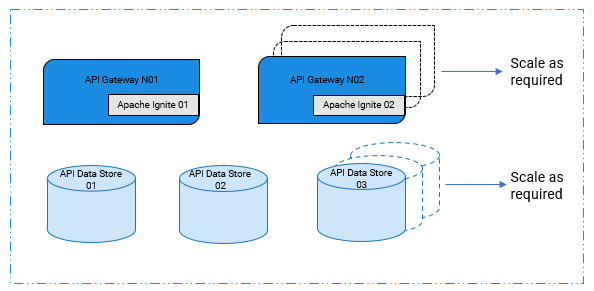Hardware and Product Configurations
Installing Software AG Products On Premises document provides the minimum system requirements to run API Gateway. These configurations change based on the production needs.
This section provides the hardware and product configuration guidelines that are required to setup API Gateway to run at an optimal scale. The hardware and product configuration guidelines are proposed for the following deployment architecture.
As an alternative for Apache Ignite, Terracotta Server Array can be used to set up a cluster. For more information about the cluster deployment, see
Cluster Deployment. This is one of the architectures that is driven by availability and throughput factors. For information about the other variants of deployment architectures that is influenced by security, see
Paired Deployment.
Typically, the parameters that influence the deployment architecture and the configurations are high availability, transactions per second (TPS), data volume, security requirements and so on. The hardware and product configurations that are recommended in this chapter are tested for the following throughput values. Consider the recommended hardware and product configurations as an outcome of a case study and not an official bench marking guide.
Parameters | Value |
Transactions Per Second (TPS) | Up to 2000 Transactions Per Second. |
Data volume | Up to 500 GB Storage utilization. Purge the data if the storage utilization is above 500 GB |
Native service Latency | < 500ms |
It is important to have the right sizing for the following components of API Gateway to meet the desired throughput requirements.

API Gateway server

API Data Store (Elasticsearch)

Kibana

Terracotta
As Apache Ignite component is embedded into API Gateway, it does not require any dedicated sizing or configuration.
Apart from the sizing and configurations, to ensure high availability and optimal performance of API Gateway, it is also important to employ good data housekeeping, monitoring and other operational best practices. For details about Data housekeeping and Monitoring, see
Data Management,
Monitoring API Gateway. Additionally, it is important to consider the scaling options when there is an additional load on the system. Scaling is primarily influenced by two factors, load or TPS, and data volume. Hence, the components that are impacted for scaling are
API Gateway and API Data Store respectively. For details about scaling, see
Scaling.
Note:
These recommendations should be considered as a guideline for the specified architecture to meet the specified throughput values. You can modify the configurations according to your business requirements. These recommendations apply to both Ignite based API Gateway cluster and Terracotta Server Array based API Gateway cluster. The sizing guidelines are specific to the components of API Gateway and does not include the resource allocations for the operating system and the other tools that you require to co-host while running API Gateway.

